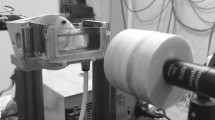Abstract
Purpose
Moses™ technology has been developed to improve holmium laser fragmentation at 1–2 mm distance from the stone. Because popcorn lithotripsy is a non-contact technique, we compared short pulse (SP) and Moses distance (MD) modes in an in vitro model.
Methods
BegoStones were fragmented using a 120 W Ho:YAG laser (P120 Moses) and a 230 μm core fiber introduced through a ureteroscope. 20 W (1 J × 20 Hz; 0.5 J × 40 Hz) and 40 W (1 J × 40 Hz; 0.5 J × 80 Hz) settings (total energy 4.8 kJ) were tested using SP and MD modes. We assessed fragment size distribution and mass lost in fluid (initial mass–final dry mass of all sievable fragments). High-speed video analysis of fragmentation strike rate and vapor bubble characteristics was conducted for 1 J × 20 Hz and 0.5 J × 80 Hz. Laser strike rate (number of strikes divided by frequency) was categorized as: (1) direct—a visual plume of dust ejected from stone while in contact with fiber tip; (2) indirect—a visual plume of dust ejected with distance between stone and fiber tip.
Results
For 1 J × 20 Hz (20 W), MD resulted in more mass lost in fluid and a lower distribution of fragments ≥ 2 mm compared to SP (p < 0.05). 0.5 J × 80 Hz (40 W) produced no fragments ≥ 2 mm, and there were no significant differences in fragment distribution between MD and SP (p = 0.34). When using MD at 1 J × 20 Hz, 96% of strikes were indirect vs 61% for SP (p = 0.059). In contrast to the single bubble of SP, with MD, there was forward movement of the collapsing second bubble, away from the fiber-tip.
Conclusions
For lower frequency and power popcorn settings, pulse modulation results in more fragmentation through true non-contact laser lithotripsy.



Similar content being viewed by others
References
Dauw CA, Simeon L, Alruwaily AF et al (2015) Contemporary practice patterns of flexible ureteroscopy for treating renal stones: results of a worldwide survey. J Endourol 29(11):1221–1230
Humphreys MR, Shah OD, Monga M et al (2018) Dusting versus basketing during ureteroscopy-which technique is more efficacious? A prospective multicenter trial from the EDGE Research Consortium. J Urol 199(5):1272–1276
Klaver P, de Boorder T, Rem AI, Lock T, Noordmans HJ (2017) In vitro comparison of renal stone laser treatment using fragmentation and popcorn technique. Lasers Surg Med 49(7):698–704
Emiliani E, Talso M, Cho SY et al (2017) Optimal settings for the noncontact holmium:YAG stone fragmentation popcorn technique. J Urol 198(3):702–706
Chawla SN, Chang MF, Chang A, Lenoir J, Bagley DH (2008) Effectiveness of high-frequency holmium:YAG laser stone fragmentation: the "popcorn effect". J Endourol 22(4):645–650
Wollin DA, Tom WR, Jiang R, Simmons WN, Preminger GM, Lipkin ME (2018) An in vitro evaluation of laser settings and location in the efficiency of the popcorn effect. Urolithiasis 47:377–382
Aldoukhi AH, Roberts WW, Hall TL, Teichman JMH, Ghani KR (2018) Understanding the popcorn effect during holmium laser lithotripsy for dusting. Urology 122:52–57
Elhilali MM, Badaan S, Ibrahim A, Andonian S (2017) Use of the Moses technology to improve holmium laser lithotripsy outcomes: a preclinical study. J Endourol 31(6):598–604
Aldoukhi AH, Roberts WW, Hall TL, Ghani KR (2018) Watch your distance: The role of laser fiber working distance on fragmentation when altering pulse width or modulation. J Endourol 33:120–126
Brenton W, Daniel W, Evan C et al (2018) Dusting efficiency of the Moses holmium laser: an automated in vitro assessment. J Endourol 32(12):1131–1135
Vassar GJTJM, Glickman RD (1998) Holmium:YAG lithotripsy efficiency varies with energy density. J Urol 160(2):471–476
Lee H, Ryan RT, Teichman JM et al (2003) Stone retropulsion during holmium:YAG lithotripsy. J Urol 169(3):881–885
Sea J, Jonat LM, Chew BH et al (2012) Optimal power settings for Holmium:YAG lithotripsy. J Urol 187(3):914–919
Chew BH, Brotherhood HL, Sur RL et al (2016) Natural history, complications and re-intervention rates of asymptomatic residual stone fragments after ureteroscopy: a report from the EDGE Research Consortium. J Urol 195(4 Pt 1):982–986
Mues AC, Teichman JMH, Knudsen BE (2009) Quantification of Holmium:Yttrium aluminum garnet optical tip degradation. J Endourol 23(9):1425–1428
Aldoukhi AH, Ghani KR, Hall TL, Roberts WW (2017) Thermal response to high-power holmium laser lithotripsy. J Endourol 31(12):1308–1312
Aldoukhi AH, Hall TL, Ghani KR, Maxwell AD, MacConaghy B, Roberts WW (2018) Caliceal fluid temperature during high-power holmium laser lithotripsy in an in vivo porcine model. J Endourol 32(8):724–729
Author information
Authors and Affiliations
Contributions
KMB: protocol/project development, data collection or management, data analysis, manuscript writing/editing. AHA: protocol/project development, data collection or management, data analysis, manuscript writing/editing. JMT: data analysis, manuscript writing/editing. SEM: data collection or management, data analysis. TLH: data analysis, manuscript writing/editing. WWR: data analysis, manuscript writing/editing.
Corresponding author
Ethics declarations
Conflict of interest
KRG is a consultant for Boston Scientific and Lumenis; WWR is a consultant for Boston Scientific. JMHT has research grants from Boston Scientific, Lumenis, and Cook Urologic. This study was funded by a scientific investigator grant from Boston Scientific.
Research involving human participants and/or animals
This research study did not involve the use of human or animal subjects.
Informed consent
Informed consent was not needed due to the nature of the in vitro study.
Additional information
Publisher's Note
Springer Nature remains neutral with regard to jurisdictional claims in published maps and institutional affiliations.
Electronic supplementary material
Below is the link to the electronic supplementary material.
SP Mode: High-speed (30,000 FPS) video analysis of SP mode at 1Jx20Hz (M4V 164 kb)
MD Mode: High-speed (30,000 FPS) video analysis of MD mode at 1Jx20Hz (M4V 138 kb)
Rights and permissions
About this article
Cite this article
Black, K.M., Aldoukhi, A.H., Teichman, J.M.H. et al. Pulse modulation with Moses technology improves popcorn laser lithotripsy. World J Urol 39, 1699–1705 (2021). https://doi.org/10.1007/s00345-020-03282-0
Received:
Accepted:
Published:
Issue Date:
DOI: https://doi.org/10.1007/s00345-020-03282-0




